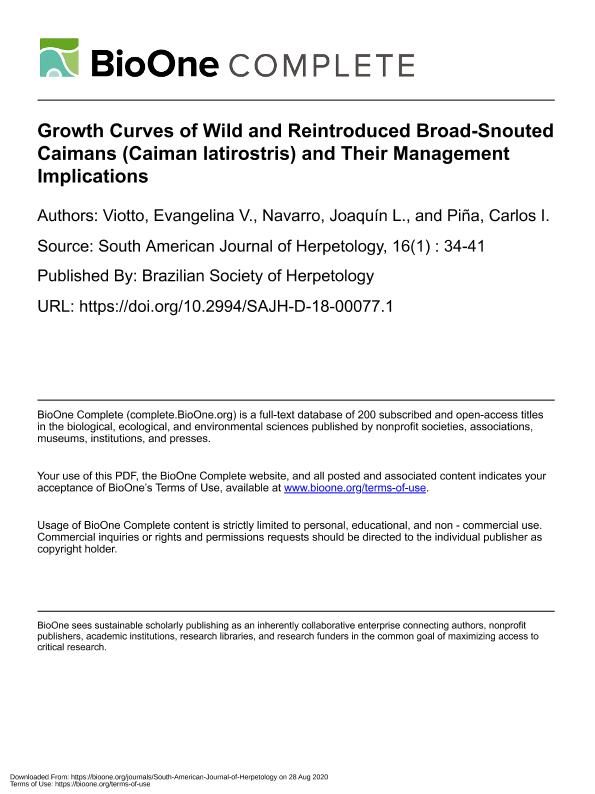Mostrar el registro sencillo del ítem
dc.contributor.author
Viotto, Evangelina del Valle

dc.contributor.author
Navarro, Joaquin Luis

dc.contributor.author
Piña, Carlos Ignacio

dc.date.available
2021-10-04T20:59:13Z
dc.date.issued
2020-08
dc.identifier.citation
Viotto, Evangelina del Valle; Navarro, Joaquin Luis; Piña, Carlos Ignacio; Growth Curves of Wild and Reintroduced Broad-Snouted Caimans (Caiman latirostris) and Their Management Implications; Sociedade Brasileira de Herpetologia; South American Journal of Herpetology; 16; 1; 8-2020; 34-41
dc.identifier.issn
1982-355X
dc.identifier.uri
http://hdl.handle.net/11336/142566
dc.description.abstract
We describe body growth functions of broad-snouted caimans (Caiman latirostris) for wild and reintroduced individuals. Snout-vent length (SVL, cm) and age of young individuals and adult females were recorded for two different groups: (Py) animals born in the Proyecto Yacaré ranching program, from eggs collected in the wild; and (Wy) wild caimans Class I (< 25 cm SVL) whose age was determined by Size Frequency Analysis, plus females reintroduced by the Proyecto Yacaré and subsequently recaptured at reproductive age. To describe body growth, we adjusted five models through non-linear regression: Logistic, 4-Parameter Logistic (4-PL), Gompertz, 4-Parameter Gompertz (4-G), and von Bertalanffy. Each group was analyzed separately (Py and Wy), and we selected the most parsimonious model based on the Akaike criterion. We also analyzed the possible linear growth difference using ANCOVA. For Py, the Logistic model was best, whereas for Wy the most suitable was 4-PL, in which wild animals would arrive at the inflexion point 1.4 years later on average than in Py. Analyzing the stage at which their development was linear in shape, we detected that the wild animals had a similar growth rate to reintroduced individuals. As a result, although Py animals had experienced accelerated development whilst in captivity, it did not modify their subsequent growth in the wild. The likelihood of survival in this species increases with body size, thus it is important to emphasize that reintroduced animals are larger than wild animals of the same age and that previous farming conditions seem not to affect their growth in the wild. Therefore, we expect that reintroduced caimans will exhibit greater survivorship than natural animals of the same age. Consequently, an adjustment of the current ranching program should be considered, in the sense that population viability could be achieved by reintroducing a lower number of caimans each season.
dc.format
application/pdf
dc.language.iso
eng
dc.publisher
Sociedade Brasileira de Herpetologia
dc.rights
info:eu-repo/semantics/openAccess
dc.rights.uri
https://creativecommons.org/licenses/by-nc-sa/2.5/ar/
dc.subject
GROWTH MODELS
dc.subject
NONLINEAR REGRESSION
dc.subject
RANCHING
dc.subject
WILD ANIMALS
dc.subject.classification
Ecología

dc.subject.classification
Ciencias Biológicas

dc.subject.classification
CIENCIAS NATURALES Y EXACTAS

dc.title
Growth Curves of Wild and Reintroduced Broad-Snouted Caimans (Caiman latirostris) and Their Management Implications
dc.type
info:eu-repo/semantics/article
dc.type
info:ar-repo/semantics/artículo
dc.type
info:eu-repo/semantics/publishedVersion
dc.date.updated
2021-09-06T15:44:20Z
dc.journal.volume
16
dc.journal.number
1
dc.journal.pagination
34-41
dc.journal.pais
Brasil

dc.description.fil
Fil: Viotto, Evangelina del Valle. Provincia de Entre Ríos. Centro de Investigaciones Científicas y Transferencia de Tecnología a la Producción. Universidad Autónoma de Entre Ríos. Centro de Investigaciones Científicas y Transferencia de Tecnología a la Producción. Consejo Nacional de Investigaciones Científicas y Técnicas. Centro Científico Tecnológico Conicet - Santa Fe. Centro de Investigaciones Científicas y Transferencia de Tecnología a la Producción; Argentina. Universidad Nacional del Litoral. Facultad de Humanidades y Ciencias. Departamento de Ciencias Naturales. Laboratorio de Zoología Aplicada: Anexo Vertebrados (FHUC-UNL/MASPyMA); Argentina
dc.description.fil
Fil: Navarro, Joaquin Luis. Consejo Nacional de Investigaciones Científicas y Técnicas. Centro Científico Tecnológico Conicet - Córdoba. Instituto de Diversidad y Ecología Animal. Universidad Nacional de Córdoba. Facultad de Ciencias Exactas Físicas y Naturales. Instituto de Diversidad y Ecología Animal; Argentina. Universidad Nacional de Córdoba. Facultad de Ciencias Exactas, Físicas y Naturales. Centro de Zoología Aplicada; Argentina. Universidad Nacional de Córdoba. Facultad de Ciencias Exactas, Físicas y Naturales. Departamento de Diversidad Biológica y Ecológica. Cátedra de Problemática Ambiental; Argentina
dc.description.fil
Fil: Piña, Carlos Ignacio. Provincia de Entre Ríos. Centro de Investigaciones Científicas y Transferencia de Tecnología a la Producción. Universidad Autónoma de Entre Ríos. Centro de Investigaciones Científicas y Transferencia de Tecnología a la Producción. Consejo Nacional de Investigaciones Científicas y Técnicas. Centro Científico Tecnológico Conicet - Santa Fe. Centro de Investigaciones Científicas y Transferencia de Tecnología a la Producción; Argentina. Universidad Nacional del Litoral. Facultad de Humanidades y Ciencias. Departamento de Ciencias Naturales. Laboratorio de Zoología Aplicada: Anexo Vertebrados (FHUC-UNL/MASPyMA); Argentina. Universidad Autónoma de Entre Ríos. Facultad de Ciencia y Tecnología; Argentina
dc.journal.title
South American Journal of Herpetology
dc.relation.alternativeid
info:eu-repo/semantics/altIdentifier/url/https://bioone.org/journals/south-american-journal-of-herpetology/volume-16/issue-1/SAJH-D-18-00077.1/Growth-Curves-of-Wild-and-Reintroduced-Broad-Snouted-Caimans-Caiman/10.2994/SAJH-D-18-00077.1.full
dc.relation.alternativeid
info:eu-repo/semantics/altIdentifier/doi/http://dx.doi.org/10.2994/SAJH-D-18-00077.1
Archivos asociados
